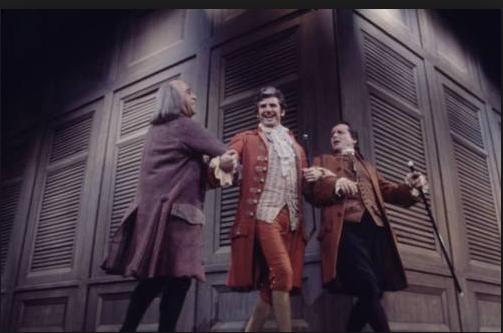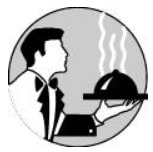|
Tomorrow, as is the smart, wonderful, and happy custom, TCM will be airing their annual broadcast of the movie musical, 1776. (Well, sort of. It was be tomorrow on the West Coast, airing at 11:30 PM. Everywhere else, it won't be on until the early morning July 5. Why in the world they scheduled it that way is between them, and their God, and George Washington.) I mention this for two reasons. The first is because the very first Broadway musical I ever saw actually on Broadway was 1776. Happily, it was still with the original cast, William Daniels, Howard Da Silva, and Ken Howard, all who recreated their roles in the film version. The show was absolutely wonderful, later winning both the Tony Award and Pulitzer Prize. The score is by Sherman Edwards, who'd been a history teacher earlier in his life, but then became a songwriter, and had some hits, most notably, "Wonderful, Wonderful," for Johnny Mathis. Because of his interest in history, Edwards came up with the idea of 1776 and even wrote the first draft of the script, but eventually that was thrown out, and Peter Stone was brought in. The stage show is done without intermission, which keeps the focus on the story very tight, something important in its telling, since one of the truly remarkable achievements of 1776 is how tense and riveted it keeps the audience, wondering on the edge of their seats what will happen as the vote for independence nears. (Spoiler alert: the U.S. declares independence.) In fact, the theater erupted into cheers when the vote is announced. Also remarkable for a musical comedy is that during one long stretch there is gripping political debate, and almost 30 minutes pass without a song. The movie version was released in 1972, and in a deeply surprising, but terrific decision, it used most of the original Broadway cast -- none of whom were remotely movie stars. And those in the movie who had not been in the original cast had appeared in either a touring company of the show or replacement cast on Broadway. Also, the stage director, Peter H. Hunt, directed the film. Despite all this, when the movie came out, I was deeply disappointed. In fact, I came close to hating it. It seemed so cartoonish. I couldn't figure out why, since so much was the same from what I'd seen on Broadway. I late discovered the reason: about 40 minutes were cut from the show, most of which was the serious, political debate -- the material that gave 1776 such depth. I later found out, too, that all that material had actually been shot, but cut, mainly at the behest of producer Jack L. Warner. When the laserdisc was released years later (remember laserdisc?!), much of that material was put back in, some just black-and-white workprints. But it was significantly better than the original film, almost to the point of now being quite good. Then, with DVDs, director Hunt found even more material, and also was able to use digital technology to fix the color on everything. As a result, today, a "Deluxe Directors Cut" now exists and properly presents 1776 the way it's supposed to be. (And that's the version TCM shows.) You can tell which is which easily -- the correct version runs 165 minutes. The lame, movie-release version was a little over two hours. The film is now terrific. Most famous among the restored scenes is the song, "Cool, Cool Considerate Men," in which the conservatives in the Continental Congress defend their actions trying to hold off declaring independence. Producer Jack Warner was a very far-right conservative and hated the number, thinking it showed conservatives in a bad light. (Personally, I love the song because it humanizes them and gives rational reason for their concerns about taking a treasonous act against England.) As the story goes, Warner supposedly took the film to then-president Richard Nixon and asked his opinion. Nixon apparently hated the scene, too. And Warner not only ordered the song cut -- but ordered all work prints destroyed, as well, so that it could never be put back in. And there the story stood...until decades later, when the restored laserdisc was being put together, with the help of original director Hunt. As they searched for lost material, to their shock they discovered a very bad print of "Cool, Cool Considerate Men" down in a salt mine, where a print of the movie had been kept to protect it. It's since been "cleaned up" digitally, and now, on the DVD, is restored in its full glory. (So there, Jack Warner...) Which brings us to the second reason I mention all this (at length...). That's because of the one thing in the movie I hate. It's the "Lees of Old Virginia" number, sung by the character of Richard Henry Lee, as performed by Ronald Holgate. The scene is silly, to the point of inanely stupid. And what's odd is that Ronald Holgate not only was recreating the role he performed in the original stage production, but he was so brilliant in it that he won the Tony Award for Best Featured Actor in a Musical. For that one scene, alone. And it had to have been for that one scene only, because he doesn't do much else in the musical. But in that one scene, he comes close to stopping the show. He's that brilliant. Yet people who've only seen him in the movie tend to think he's clownish, and are gobsmacked when I tell them that he won the Tony for it on stage. And that kills me, because it was one the things in the movie I was most looking forward to. On stage, he was... remarkable. Alas, I know what went wrong.
On stage, Holgate sings this wildly exuberant song for 2-1/2 minutes. Egomaniacally leaping, dancing and prancing across the stage, high-kicking his legs up high in the air, jumping and swirling around, engulfing the entire theater with his joy and ego that he, of the proud Lees of Viriginia, will be able to do what others have failed at, bring independence to America. And Holgate does this breathlessly for 2-1/2 minutes, live, non-stop, no cuts to catch a breath, all in front of you with more enthusiasm that you believe a person could have in their body. It was a tour-de-force performance. On film...it was staged differently. There are clearly cuts, so you know he had time to pause and rest. Close-ups, long shots and most idiotically of all, riding around on a horse. No doubt the horse was thought to be cinematic -- it just looks stupid. And more importantly, the horse is doing all the work. The actor is just sitting there. Moreover, what was big and grandiose on stage and needed to fill a theater comes across as over-the-top on a movie screen. So, in the end, as wonderful a job as director Peter Hunt did with the whole movie, he let down Ronald Holgate here. He should have done three things -- 1) He should have restaged Holgate's performance to tone it down from bigger-than-life mugging for the camera while retaining the exuberance in a simpler way, perhaps starting small and building it to a point of explosion. 2) He should have done what Fred Astaire often did: set up the camera to catch him full-body and never cut away. Let Ronald Holgate give a non-stop performance on film. It might have been less cinematic, but it would have blown away the audience. And Holgate could have done it -- he did it every night on stage, eight shows a week. And 3) Get rid of the freaking horse!!! Oh, well. That's the way it goes. But at least I said my piece now and was able to correct the record in just a small way. And though there's no video footage that I'm aware of on Ronald Holgate performing "The Lees of Old Virginia" live on stage, here at least is the audio version of it from the original cast recording. (Note: when the cast album was recorded, Howard Da Silva had previously had a heart attack, so couldn't perform on it. But he returned to the show soon after.) By the way, if you listen to this in stereo, you'll note Ronald Holgate moving back-and-forth -- and back-and-forth between speakers. That's him recreating what he did on stage, high-kicking, jumping and leaping everywhere, all the while singing in his well-deserved, Tony-winning performance.
6 Comments
Douglass Abramson
7/3/2013 01:11:41 pm
I've never seen 1776 on stage, but I've loved the film since I discovered it one weekend on The Family Film Festival on KTLA when I was a kid. I agree that the Director's cut is the superior version of the film and I think that the arrangement of the Lee song is better on the original soundtrack, but I like the horse. The best thing that the horse does during the number wasn't even scripted. According to the commentary on the DVD, when Holgate kneels and bows to Daniels and DaSilva; the horse bows his head too. I'll acknowledge that its a little silly, but I do love that shot.
Reply
Robert Elisberg
7/3/2013 03:15:15 pm
Mainly, I'm just glad that the Deluxe Edition exists, and that far transcends any quibbles. And I understand personal tastes. But if one saw Ronald Holgate's performance on stage, it would be clear why he won the Tony Award. And fun though his film version might be, it's not one that people look at and say, "That's Oscar-winnning."
Reply
Douglass Abramson
7/3/2013 04:00:24 pm
Good point. I guess that I'm just glad that as much of the original show and actors made it into the film. If I had seen it on Broadway, or had been exposed to the score beforehand, I probably wouldn't be as satisfied. I have that problem with A Funny Thing Happened on the Way to the Forum. My Dad saw the original cast on Broadway. His first Broadway show. I grew up listening to the original cast record, over and over again. When I finally had the chance to see the movie...let's just say that I wanted to know who was responsible. How you screw up a Gelbart book, Sondheim songs and the talents of Mostel, Gilford, Silvers and Crawford is beyond me.
Reply
Robert Elisberg
7/3/2013 10:59:20 pm
Just to clarify, having seen it on Broadway, I'm extremely pleased by movie of "1776" now, because with the Deluxe Director's Cut so much of it finally made it to film, and with most of the original cast.
Reply
Greg Checketts
7/4/2013 03:17:57 am
One of Ron Holgate's fellow nominees was William Daniels from the same show, but he had turned down the nomination since he felt John Adams was really a leading role and not a featured one. This is mindless supposition, but since you saw the original production, I'm just curious: do you think that if he hadn't turned it down, Ron Holgate would have still won? Not to take anything away from either gentleman, because I love this show, and I think the movie is extraordinarily well acted. John Adams is a bigger part and it's a career defining role for William Daniels. But, on the other hand, there are some performances just catch fire live, even if it doesn't necessarily translate that same kind of energy on film, and Ron Holgate is just glorious singing that song on the film soundtrack (although I do agree that the editing choices are particularly unfortunate in that sequence-- I like listening to that number far more than watching it!)
Reply
Robert Elisberg
7/4/2013 05:25:10 am
There's actually more of a story behind William Daniels nomination. At that time, the Tonys had a rule that the only people eligible to be nominated as "Leading Actor" are those whose names were above the title, or -- if below -- say, "Starring." With "1776," all of the actors were listed together under the title. So, Daniels wasn't eligible to a "Lead Actor" nomination.
Reply
Leave a Reply. |
AuthorRobert J. Elisberg is a political commentator, screenwriter, novelist, tech writer and also some other things that I just tend to keep forgetting. Feedspot Badge of Honor
Categories
All
|
|
© Copyright Robert J. Elisberg 2024
|







 RSS Feed
RSS Feed